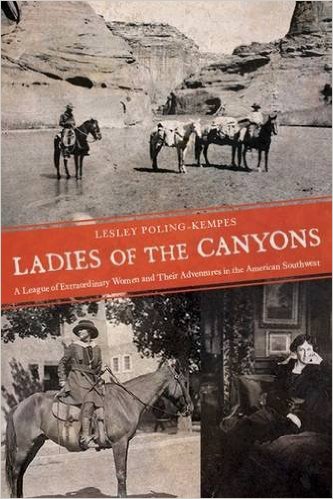 Ladies of the Canyons follows the real lives of Victorian women who left the comfort of their homes and ventured into the American Southwest at a time when it was viewed as “exotic at best and primitive and downright dangerous at worst.” Published by The University of Arizona Press in September of 2015, this work of nonfiction fills a gap left by other historical texts. The author, Lesley Poling-Kempes, “was looking for a woman who had gone missing from history,” Carol Bishop Stanley, who was the founder of Ghost Ranch, which would gain fame as the “faraway nearby home of the American artist Georgia O’Keefe.” In searching for Carol’s story, Poling-Kempes found a whole cast of remarkable women. Through the archived material of letters, diaries, newspapers, and the like, Poling-Kempes was able to piece together the stories and subsequent alliance of women who found the lives they always wanted, the lives they may not have known they were searching for, in the American Southwest.
Ladies of the Canyons follows the real lives of Victorian women who left the comfort of their homes and ventured into the American Southwest at a time when it was viewed as “exotic at best and primitive and downright dangerous at worst.” Published by The University of Arizona Press in September of 2015, this work of nonfiction fills a gap left by other historical texts. The author, Lesley Poling-Kempes, “was looking for a woman who had gone missing from history,” Carol Bishop Stanley, who was the founder of Ghost Ranch, which would gain fame as the “faraway nearby home of the American artist Georgia O’Keefe.” In searching for Carol’s story, Poling-Kempes found a whole cast of remarkable women. Through the archived material of letters, diaries, newspapers, and the like, Poling-Kempes was able to piece together the stories and subsequent alliance of women who found the lives they always wanted, the lives they may not have known they were searching for, in the American Southwest.
An epigraph precedes each chapter of Ladies of the Canyons. The one before chapter seventeen seems to speak well to the overall spirit of the book: “The new woman means the woman not yet classified, perhaps not classifiable, the woman new not only to men, but to herself.” Ultimately, Ladies of the Canyons is the story of women finding their own way when society was telling them that their duty was, as unmarried women, at home with their parents. These are stories of self-discovery. Women such as Natalie Curtis, Carol Stanley, Alice Klauber, and Mary Cabot rejected that notion set by society and found themselves transformed by the American Southwest. They created their own society and became extremely influential in that society. Their stories should be read and remembered due to their unbelievable influence in the preservation of Native American culture, the birth of American modern art, and the promotion of life and tourism in the American Southwest.
These are stories – adventures, rather – that are vastly entertaining. They are also peppered with many familiar faces. Natalie Curtis and her friendship with Theodore Roosevelt was particularly noteworthy. These are stories about women finding their own way, but they then often use their newfound power to speak up on behalf of Native Americans whose culture was being wiped out by the American Government. Natalie Curtis, a talented musician, illegally recorded Native American songs and chants in an effort to preserve them. She eventually was able to meet with Theodore Roosevelt and convince him of the importance of her work. Curtis and Roosevelt remained friends and met many times until his death in 1919. Curtis wrote “the first comprehensive collection of native songs, stories, and ceremonies,” which was published as The Indians’ Book in 1907. And this is just a taste of one great, nuanced story among many found in Ladies of the Canyons.
Ladies of the Canyons predominantly focuses on the first two decades of the twentieth century. Poling-Kopes provides interesting historical context, such as how World War I positively affected tourism in the American Southwest as trips to Europe were cancelled. And while the reader does step outside of the Southwest with trips abroad and back home to the East, providing further cultural context, there is always an eagerness on behalf of the reader for the characters to return to the Southwest. My personal interest in the American Southwest increased with every description of a new person’s arrival there and subsequent decision to call the Southwest home. The beauty of the landscape, as well as the freedom, described is enticing, even to a twenty-first-century reader. Despite great hardships, I found myself wishing to be among these New Women.
What really makes this book a worthwhile piece of nonfiction is how the hopes and dreams of the women depicted take center stage. There is just as much emotion as historical fact. As the women become invigorated by the American Southwest, and life in general, the reader roots for them, wants to see them succeed whether that be in the preservation of Native American art, music, and religion or the success of a dude ranch and marriage. Poling-Kopes seems to care about these women and the land that becomes their home, and she makes the reader care.
Rating: 4 out of 5 stars
[boxer set=”keary”]

